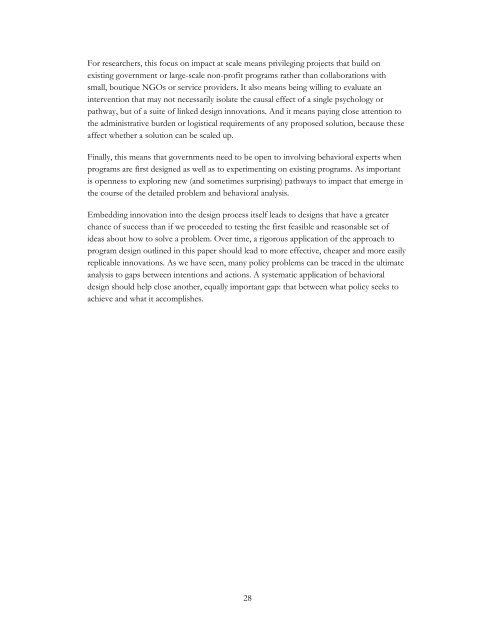For researchers, this focus on impact at scale means privileging projects that build on existing government or large-scale non-profit programs rather than collaborations with small, boutique NGOs or service providers. It also means being willing to evaluate an intervention that may not necessarily isolate the causal effect of a single psychology or pathway, but of a suite of linked <strong>design</strong> innovations. And it means paying close attention to the administrative burden or logistical requirements of any proposed solution, because these affect whether a solution can be scaled up. Finally, this means that governments need to be open to involving <strong>behavioral</strong> experts when programs are first <strong>design</strong>ed as well as to experimenting on existing programs. As important is openness to exploring new (and sometimes surprising) pathways to impact that emerge in the course of the detailed problem and <strong>behavioral</strong> analysis. Embedding innovation into the <strong>design</strong> process itself leads to <strong>design</strong>s that have a greater chance of success than if we proceeded to testing the first feasible and reasonable set of ideas about how to solve a problem. Over time, a rigorous application of the approach to program <strong>design</strong> outlined in this paper should lead to more effective, cheaper and more easily replicable innovations. As we have seen, many policy problems can be traced in the ultimate analysis to gaps between intentions and actions. A systematic application of <strong>behavioral</strong> <strong>design</strong> should help close another, equally important gap: that between what policy seeks to achieve and what it accomplishes. 28
References Allcott, H. and Mullainathan, S. (2010). “Behavior and Energy Policy.” Science, Vol. 327, No. 5970:1204-1205. Ashraf, N., Karlan, D., and Yin, W. (2006). “Tying Odysseus to the Mast: Evidence from a Commitment Savings Product in the Philippines.” Quarterly Journal of Economics, May 2006. Banerjee, A. and Duflo, E. (2011). Poor Economics : A Radical Rethinking of the Way to Fight Global Poverty. Public Affairs Banerjee, A., Duflo, E., Glennerster, R., and Kothari, D. (2010) “Improving immunisation coverage in rural India: clustered randomised controlled evaluation of immunization campaigns with and without incentives.” BMJ 340:c2220 Banerjee, A. and Mullainathan, S. 2008. “Limited Attention and Income Distribution.” American Economic Review 98(2) Banik, P., Midya A., Sarkar B.K., Ghose, S.S., (2006) “Wheat and Chickpea Intercropping Systems in an Additive Series Experiment: Advantages and Weed Smothering,” European Journal of Agronomy, 24: 325-332. Bernheim, B.D., Ray, D. and Yeltekin, S. 2012. “Poverty and Self-control.” Mimeo, New York University Department of Economics Bertrand, M., Karlan, D. Mullainathan, S., Shafir, E., and Zinman, J. (2010) ““What’s Advertising Content Worth? Evidence from a Consumer Credit Marketing Field Experiment.” The Quarterly Journal of Economics, Vol. 125, No. 1: 263–305 Bertrand, M., Mullainathan, S., and Shafir, E. (2004). "A Behavioral Economics View of Poverty," The American Economic Review, 94 (2), 419-423 Brune, L., Gine, X., Goldberg, J. and Yang, D. (2011). “Commitments to save: A field experiment in rural Malawi.” World Bank Policy Research Working Paper no. 5748, August 2011 Cadena, X., Schoar, A., Cristea, A., and Delgado-Medrano, H. (2011). “Fighting Procrastination in the workplace: An experiment.” NBER Working Paper No. 16944, April 2011 Ciriolo, E. (2011). “Behavioural Economics in the European Union: Past, Present and Future.” OXERA Chaudhury, Nazmul, Jeffrey S. Hammer, Michael Kremer, Karthik Muralidharan, and F. Halsey Rogers. 2006. "Missing in Action: Teacher and Health Worker Absence in Developing Countries." Journal of Economic Perspectives 20(1): 91-116. Devoto, F. Duflo, E., Dupas, P., Pariente, W., Pons, V. (2011) “Happiness on Tap: Piped Water Adoption in Urban Morocco.” American Economic Journal: Public Policy, September 2011 Drexler, A., Fischer G., Schoar A., (2011) “Keeping It Simple: Financial Literacy and Rules of Thumb.” Duflo, E., Kremer, M., and Robinson, J. (2011) “Nudging Farmers to Use Fertilizer: Evidence from Kenya.” American Economic Review 101 (6): 2350-2390, October 2011 29
- Page 1 and 2: Center for Global Development 1800
- Page 3 and 4: 1. From Evaluation to Design 1.1 Th
- Page 5 and 6: the consequences of these psycholog
- Page 7 and 8: wake up later and go less often to
- Page 9 and 10: Sometimes we can change behavior wi
- Page 11 and 12: things farmers do not do enough of,
- Page 13 and 14: Figure F 4: Text t Message Re emind
- Page 15 and 16: problem as arising from a combinati
- Page 17 and 18: But in the case of grains, too much
- Page 19 and 20: Poor people in the developing world
- Page 21 and 22: with the timing of such large payme
- Page 23 and 24: science suggests that it might be m
- Page 25 and 26: Small incentives, frequently paid,
- Page 27 and 28: Most individuals make efforts to co
- Page 29: ehavioral insights allow us to unde
- Page 33: Morris, M., Kelly, V., Kopicki, R.,


